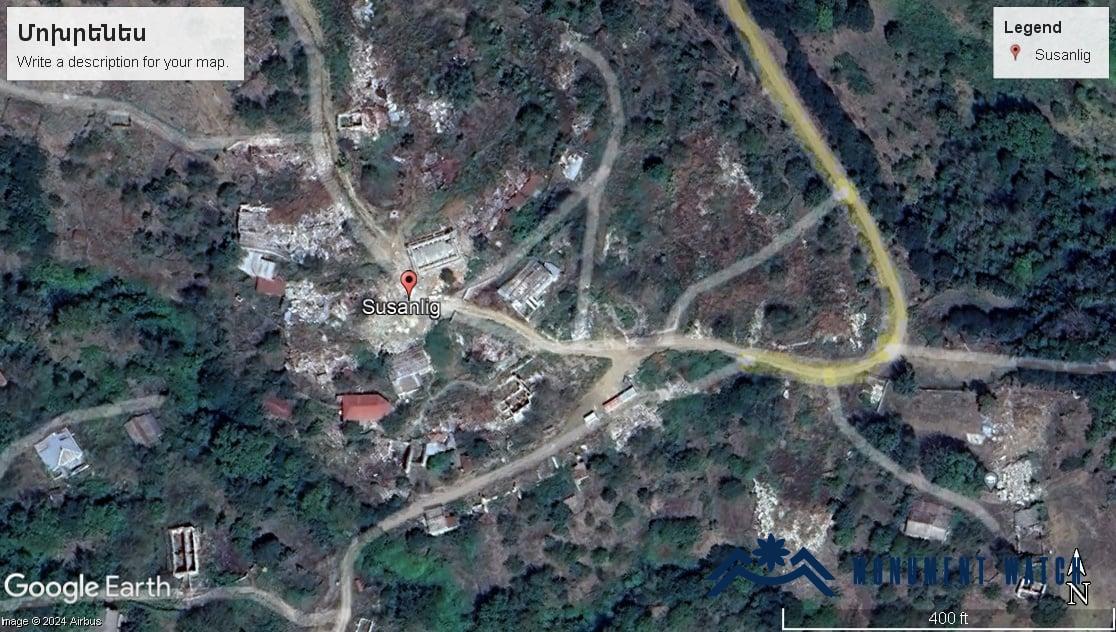The Mokhrenes village has been the target of Azerbaijani attacks
Based on satellite photos (Fig. 1), the Azerbaijani forces have destroyed the village of Mokhrenes in the Hadrut region of Artsakh, which has been under Azerbaijani control since October 2020. The village's houses, school, and kindergarten have been destroyed.
In 2022, Azerbaijan also destroyed the Surb Sargis Church in the village. Mokhrenes village and its surroundings are rich in historical monuments. There are more than 20 monuments in the territory of Mokhrenes village, including the famous "Okhty Drni" monastery located nearby. As a result of these destructive operations, the monuments around the village are in direct danger.
As a result of large-scale road construction and infrastructural projects carried out by the Azerbaijani side in occupied Artsakh since 2021, many villages in Artsakh have faced significant destruction. The villages of the Hadrut region and their surrounding areas are particularly at risk due to the construction of two new roads leading to Shushi. The extensive construction activities required for these roads, along with the associated infrastructure, have led to the destruction of large areas. This includes the accumulation of construction equipment, housing for maintenance personnel, and storage of construction materials and waste. Often, various engineering challenges were addressed at the expense of destroying Armenian villages and their houses https://monumentwatch.org/hy/alerts/ադրբեջանական-ճանապարհները-և-վտանգ. The destruction of Mokhrenes village is likely the result of these deliberate actions.
Our response
When considering the destruction of infrastructures and cultural monuments in Mokhrenes village within the broader framework of cultural heritage, it is important to note that both material structures and intangible heritage, including traditions, stories, and the living culture of the people, were targeted. According to the 21st-century strategy document for cultural heritage adopted by the Council of Europe, heritage is defined as follows: Cultural heritage, encompassing both tangible and intangible dimensions, skills, know-how, ideas, attitudes, and other elements, is inextricably linked to its context and the natural and cultural environment in which it was formed (Recommendation of the Committee of Ministers to member States on the European Cultural Heritage Strategy for the 21st century, (Adopted by the Committee of Ministers on 22 February 2017 at the 1278th meeting of the Ministers' Deputies),p․ 3). Therefore, any destruction of Artsakh's cultural heritage not only results in the physical loss of the given value but also harms the identity of the people disrupts the natural environment, and significantly damages the right to culture of Artsakh Armenians. The forced removal of the people of Artsakh from their native territory, the prevention of their ability to engage with their heritage, contribute to the cultural life of their community, keep the heritage alive, and pass it on to future generations, or the interruption of this process through forced displacement, poses a significant obstacle to the preservation and re-creation of their identity.
The destruction of the village by Azerbaijan during the war and throughout the occupation represents a series of compounded crimes, violating not only international norms for the protection of cultural heritage during wartime but also the principles of authenticity and integrity as outlined by UNESCO. These actions further contravene the decisions made by the International Court of Justice. The damage inflicted upon the village, as outlined in the 1954 Hague Convention on the Protection of Cultural Property in Armed Conflict, specifically under Article 4 of the Convention, and additionally under Article 15, paragraph (a) of the Second Protocol adopted in 1999, constitutes a "serious violation." Such acts qualify as war crimes and are prosecutable in international courts https://www.arlis.am/DocumentView.aspx?DocID=31415.
